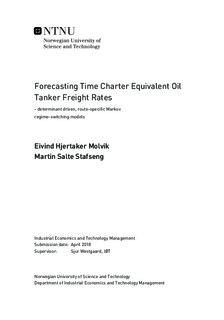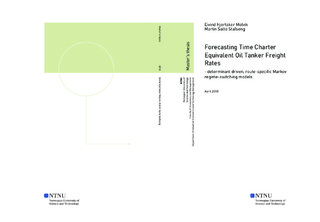| dc.description.abstract | The oil tanker market is a considerable component of the international shipping market, consisting of high risk and volatility. In this thesis we address the issue of explaining and forecasting the oil tanker freight rate for specific shipping routes. To predict the freight rate, we utilise a Markov regime-switching regression model with two states - a normal state, and a volatile state. This thesis hence postulates that predictions of short-term freight rates can be improved through a framework that can capture the distinctive nature of freight rates by switching between two distinctive regimes, while combining this with hypothetical superior route-specific and general determinants. We make a substantial attempt to combine market domain knowledge, with statistical methods. Our approach to doing so is twofold.
Firstly, we start off with a comprehensive examination of the shipping market, and more specifically the oil tanker market. By doing so we lay the foundation, and develop the necessary market understanding for the modelling later to come. Motivated by the findings in the existing literature of the driving factors of freight rates, the observations of structural breaks, and the plethora of attempts at modelling the freight rate, we characterise the market. We take an extensive look at the shipping market, how supply and demand affects the freight rate, and the cyclical nature of this rate. Furthermore, the various shipping routes are examined thoroughly. Six routes, namely TD1, TD3, TD7, TD12, TC1, and TC2, are selected to be used in this thesis. An extensive evaluation of the determining factors of the freight rate is then performed. The factors are grouped into supply-driving factors, demand-driving factors, and economic and non-fundamental factors, and are distinguished by each route. These factors are imperative for the model development.
Secondly, we develop a Markov regime-switching regression model for one-month ahead forecasting of the oil tanker freight rate, on different routes. The data is tested for structural breaks using a Chow test, and indications of multiple regimes are found. A candidate predictor analysis is done, based on subsampling in combination with a selection algorithm. Here, we look to validate the determining factors of the freight rate, which were previously selected based on existing literature. By using the novel approach of stability selection and Lasso penalization with a random tuning parameter, we were able to rank the factors based on their potential modelling importance. With a subset of variables for each route, we formulated the two-regime regression model with switching coefficients. Seasonal changes and varying lags were accounted for, and the result was six regime models, each tailored specifically to an oil tanker shipping route.
The forecasting model was then evaluated based on three objectives on out-of-sample data for each route. i) First, an evaluation of whether similar parsimonious models outperforms variable rich models. This meant creating six additional parsimonious regime models, one for each route. The parsimonious models were found to provide better predictions by evaluation of performance metrics and the Diebold-Mariano (DM) test for forecasting accuracy. ii) Secondly, an assessment of the forecasting capabilities of the regime model on never-before-seen data. These models yielded promising results, and consistently ranked in the top positions when compared to benchmark models. iii) Third, an evaluation of the benefit of developing models for specific routes. The route specific regime models were compared to a generic benchmark regime model with global variables. Such route specific regime models were found to provide valuable outcomes, and improved the forecast in most cases.
Additional findings and potential improvements were then discussed. | |

